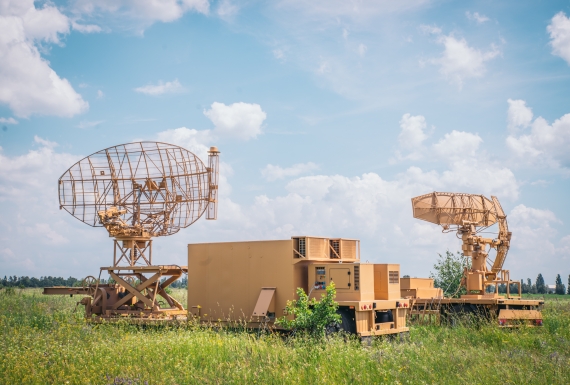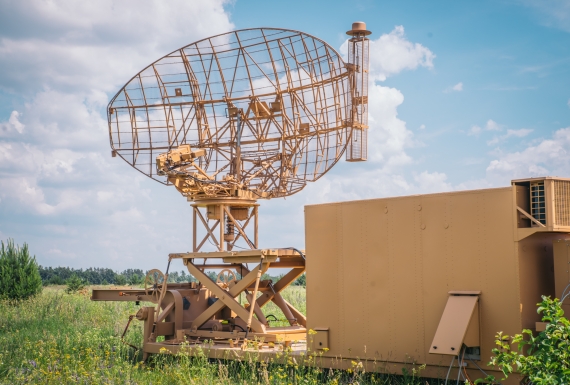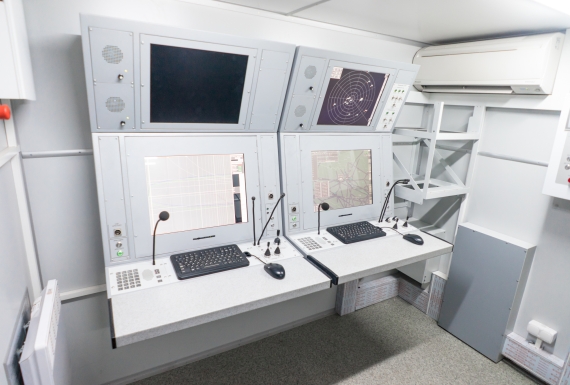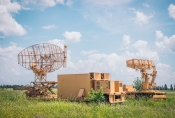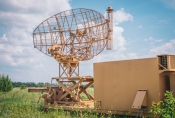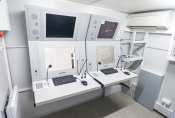RSP-10ML
- Home
- Radar systems
- RSP-10ML
Upgraded Ground-Controlled Approach (GCA) system RSP-10ML ("Long Talk") is intended to ensure flight safety of aircraft and helicopters within terminal airspace, obtain positional information and guide aircraft to a safe landing in normal and adverse weather conditions. RSP-10ML consists of the surveillance radar (ASR) combining primary and secondary channels and Precision Approach Radar (PAR).
Primary channel of RSP-10ML operates in L-band (ICAO), secondary channel uses standard frequencies for RBS (interrogation – 1030 MHz, response – 1090 MHz) and Eastern UVD (interrogation – 1030 MHz, response – 740 MHz). Primary and secondary channels work on a common antenna. Precision Approach Radar performs horizontal and glide path guidance and operates in X-band.
As a result of modernization the radar's detection performance is efficiently improved. Operator workstation implements distribution of air situation. Data can be exchanged over provided communication channels in approved format.
Transmitter and receiver of PSR/SSR feature solid-state components only. Transmitters have modular design and provide “soft-failure” redundancy: failure of individual module leads only to partial reduction in power. Antenna system of PSR/SSR is equipped with a new gear motor assembly controlled by a variable-frequency drive.
Radar includes ASR operator workstation and PAR operator workstation equipped with air situation displays and radio control panels.
All air situation is automatically recorded with playback capability in passive and interactive modes.
RSP-10ML is powered from two independent power supplies: three-phase industrial mains (380V, 50 Hz) and diesel power generators.
RSP-10ML consists of two vehicles:
- Semi-trailer No. 1 accommodating ASR antenna feed system, hardware container with Tx/Rx equipment and workstations, and diesel power supply units.
- Semi-trailer No. 2 accommodating PAR antenna, wave-guide and Tx/Rx equipment.
RSP-10ML can be transported by road, rail, sea or air.
|
Parameter |
PSR |
SSR |
|
Range of working frequencies |
1250 – 1350 MHz, |
1030 MHz – interrogation, |
|
Frequency agility: |
|
|
|
electronic |
- |
|
800 kHz |
- |
|
Supported modes |
- |
RBS, UVD and Mk XA |
|
Types of transmitted probing pulses: |
|
Modes A and C |
|
1.5 µs |
|
|
|
|
|
13-bit; |
19.5 µs |
tT=0.8 µs |
|
42 bit. |
63 µs |
tT=0.45 µs |
|
Transmitter pulse power |
2.5 kW |
1 kW |
|
Detection range for a target with RCS of 2.5m2, Р=0.5: |
|
|
|
1000 m |
2.7 km |
|
110 km |
200 km |
|
Detection accuracy: |
|
|
|
150 m |
200 m |
|
0.4° |
0.2° |
|
Resolution: |
|
|
|
250 m |
150 m |
|
5° |
5° |
|
Scanning period |
5 s |
5 s |
|
Range of adaptive MTI |
0 - 160 km |
|
|
Clutter suppression ratio |
> 35 dB |
|
|
Dynamic range of receiver and digital signal processor |
> 100 dB |
|
|
Start-up time |
3 min |
3 min |
|
Power consumption |
6 kw |
6 kw |
|
Track capacity |
Not less than 100 |
Not less than 100 |
PAR is designed to control aircraft pre-landing manoeuvring, deviation from assigned approach course and glide path.
PAR is three-dimensional radar with signal radiation and receiving principles similar to PSR. Magnetron-type transmitter of PAR radiates short nonmodulated pulses of 0.5 μs duration.
PAR performs simultaneous scanning of airspace with two antennas swinging in two planes:
- Azimuth (horizontal plane);
- Elevation (vertical plane).
Each antenna has narrow beam pattern within the scanning plane and wide beam pattern within the plane perpendicular to the scanning sector.
PAR workstation displays:
- Static data:
- 20 km and 40 km range markers;
- Azimuth markers;
- Elevation markers;
- Glide path, distance to estimated landing point;
- Synthesized echo (aircraft position);
- Indication of aircraft deviation from glide path;
- Azimuth and elevation antenna angular position indicators;
- Antenna turn and tilt control;
- PAR data recording status.
|
Parameter |
Azimuth |
Elevation |
|
|
Range of working frequencies |
9410±30 MHz (X-band) |
||
|
Coverage area: |
|
|
|
|
from -15° to +15° |
from -15° to +15° |
|
|
25 km |
25 km |
|
|
from -3° to 8° |
from -1° de 8° |
|
|
Accuracy: |
|
|
|
|
20 m |
20 m |
|
|
0.03° |
|
|
|
|
0.03° |
|
|
Resolution: |
|
||
|
80 m |
80 m |
|
|
0.8° |
|
|
|
|
0.8° |
|
|
Nominal output pulse power, not less than |
20 kW |
20 kW |
|
|
Track capacity, not less than |
20 |
20 |
|
